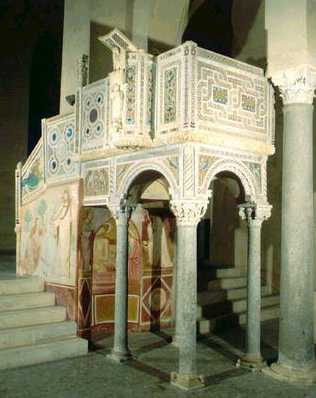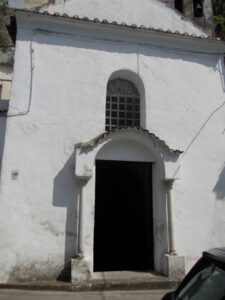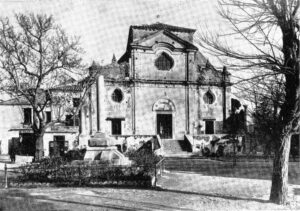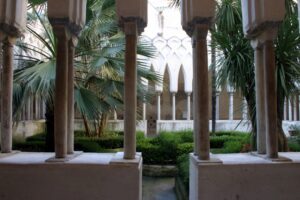MUNICIPALITY: Ravello
NAME: Church of S. Giovanni del Toro
LOCATION: Piazza S. Giovanni del Toro
DESCRIPTION: The church of S. Giovanni is in Ravello’s religious history the church where the nobility of medieval Ravello, which had its oldest palaces in this area, gathered. Its foundation should date back to the years between 975 and 1018 at the behest of the Rogadeo, Pironti and Muscettola families. The consecration took place in 1276 at the hands of Bishop Pietro of Durazzo.
The structure has three naves, apsidal, accessed by three portals, of which the central one is wider, all surmounted by spolia lintels and lunettes decorated with frescoes (only the central one survives in poor condition); the naves are divided by columns with capitals, different from each other, with Corinthian decoration enriched with plant elements, and terminated at the height of the transept, in a very elevated position (five steps) compared to the remaining part of the church, which nevertheless shows a difference in elevation between the entrance and the area immediately preceding the presbytery.
The roofing of the central nave is with exposed wooden trusses, while that of the smaller naves, as well as the area corresponding to them in the transept, is with pointed cross vaults; the central part of the transept is covered by a dome on a high drum, which partially collapsed in 1715.
Along the left aisle appears the Frezza chapel, dedicated to St. Nicholas with remains of frescoes immediately after the sacristy covered by two cross vaults, a room where it is possible to admire some partially preserved but artistically interesting frescoes. Next to the entrance door to this room a resurrected Christ between the two Marys dating from the late 1500s shows the hand of Roberto d’Odorisio, with its colors still vivid. Another fresco of the Coronation of the Virgin, originally much larger than what survives, reveals grotesque influences in the 14th-century cultural climate for this small Coppola chapel. A stucco decoration containing a relief reproduction of St. Catherine of Alexandria (identification specified by the wheel) adorned the other Coppola chapel.
The crypt is interesting: it shows in the apse area a pictorial cycle illuminating the artistic climate on the Amalfi coast in the 14th century. The Christ blessing, portrayed in the mandorla, turns out to be the center to which the figures of the saints and angels converge, immersed in geometric and floral motifs, of which the decoration is composed.
In addition to the crypt, is interesting the ambo for the proclamation of the Gospel, a 12th-century work by Alfano da Termoli, which shows a mosaic decoration rich in artistic and iconographic cues of the period. The motif showing the prophet Jonah and the sea monster (a subject similar to the cathedral’s epistle ambo) introduces a series of mosaic designs reproducing geometric, phytomorphic and animal motifs (the colors of the two Phoenician Arabs facing the round arch are a masterpiece of mosaic technique), all enriched by the presence of twenty-one majolica basins of Arab origin. Below the pulpit the reproduction of the same Christ scene, found in the sacristy, does not reveal the same artistic delicacy.
In the right nave an ancient sarcophagus from the third century AD shows all the elegance of this unknown artist’s ductus in the rendering of forms.
The facade of the church is very simple, gabled, with a bell tower on the left, square-plan and two-story with a mullioned window on each side, decorated in the structural elements by two-colored geometric motifs of tuff.
SEE,VISIT,FIND : The church is opened upon request (by addressing the Duomo/Cathedral) in winter and sporadically in summer (especially in the morning).
FRUITION DATA: None
OPPORTUNITIES: Given the historical-artistic importance of the church it should always be visitable and properly presented.
BIBLIOGRAFIA: FULCHIGNONI G., Ravello. Le cento chiese, Amalfi 2001
IMPERATO G., Ravello nella storia civile e religiosa, Cava d. T. 1990.
MANSI L., Ravello sacra – monumentale, Ravello 1887




